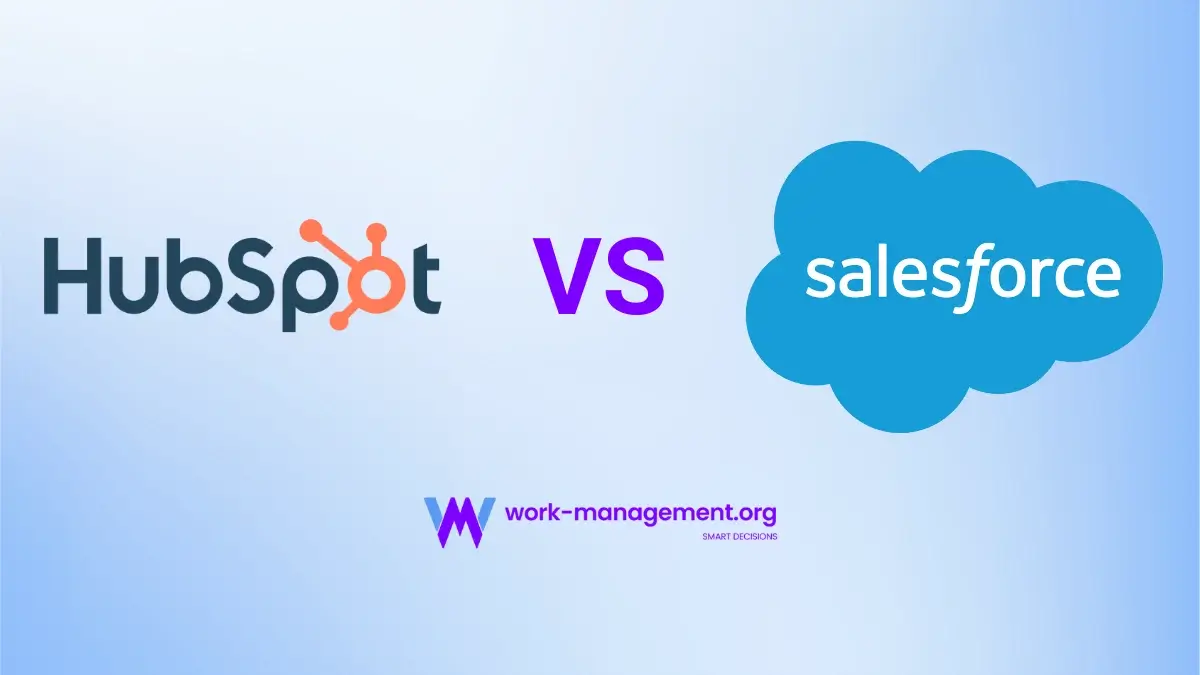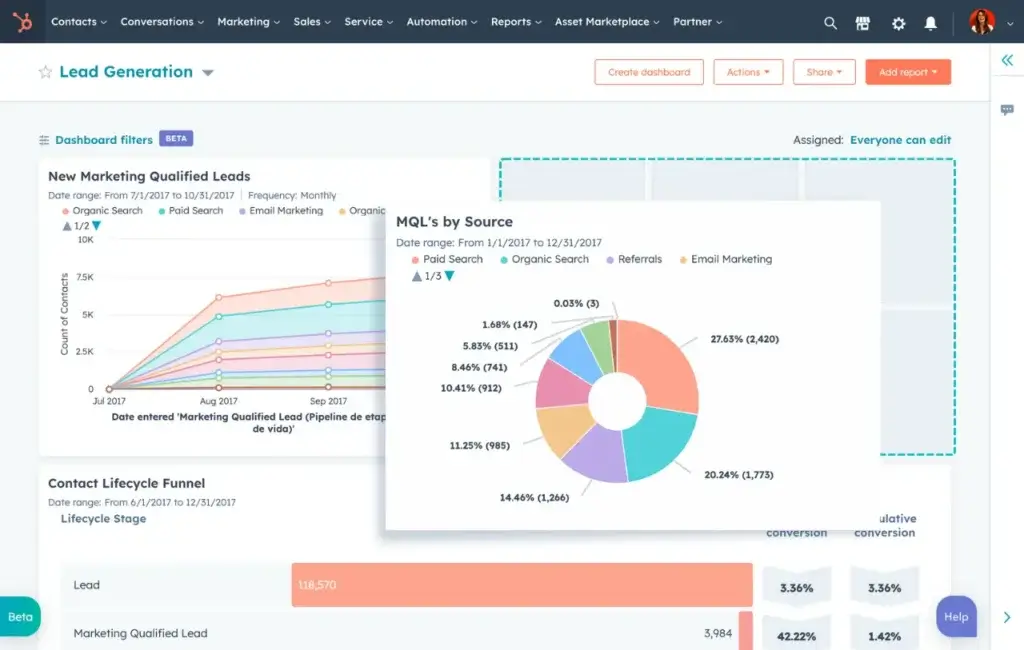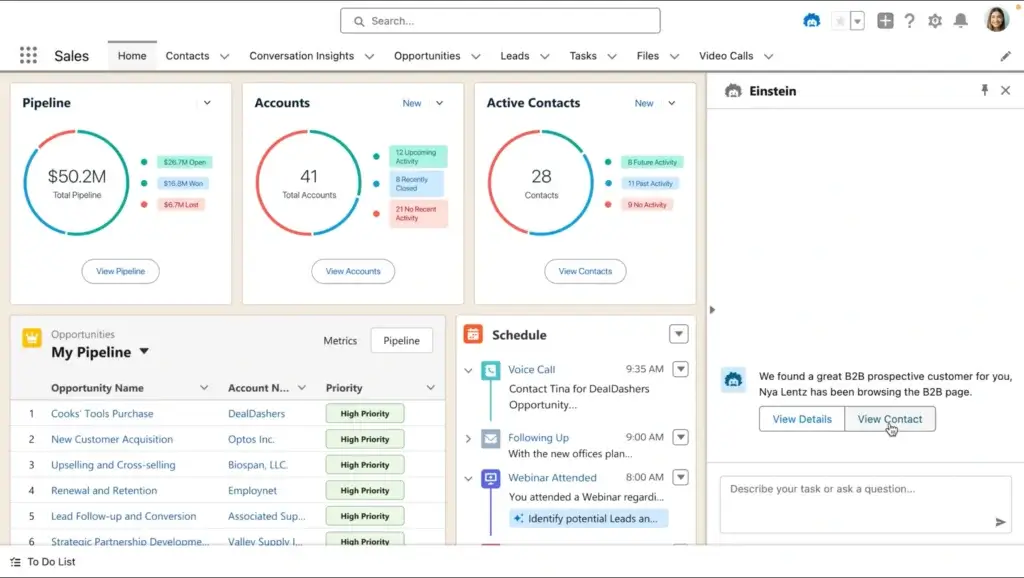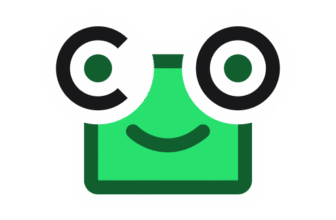
Introduction
When comparing leading CRMs, HubSpot and Salesforce stand out as two of the most widely adopted platforms, but their value propositions couldn’t be more different.
Salesforce has long been positioned as the enterprise go-to, offering deep customization and robust functionality. But that power comes at a cost: high setup fees, long onboarding cycles, and an overwhelming interface that often requires full-time admin support.
HubSpot, on the other hand, presents a more modern, accessible approach. It combines marketing, sales, and service features in one platform, with a freemium entry point and tools that scale as you grow. For SMBs and midsize teams, HubSpot often delivers more value faster, without the complexity or budget strain of Salesforce.
This side-by-side breakdown will help you decide which CRM fits your team’s needs, budget, and long-term growth. You can also compare monday CRM vs Salesforce for another leading alternative.
Pricing Breakdown
HubSpot Pricing Tiers: Free to Enterprise
HubSpot offers one of the most flexible pricing structures in the CRM market, starting with a robust free plan that includes contact management, email tracking, basic automation, live chat, and reporting.
As you grow, you can upgrade across three tiers:
-
Starter ($20/month): Unlocks advanced email marketing, custom properties, and limited automation.
-
Professional ($500/month): Adds workflows, custom reports, sales forecasting, and more.
-
Enterprise ($1,200+/month): Includes hierarchical teams, predictive lead scoring, and sandboxes.
You can also bundle HubSpot’s Marketing, Sales, and Service Hubs for an all-in-one growth suite, often at a lower total cost than Salesforce modules.
✅ Best value: HubSpot’s free and Starter plans provide substantial CRM power without upfront costs.
Salesforce Pricing Tiers: Starter to Unlimited
Salesforce pricing starts at:
-
Starter Suite ($25/user/month): Limited CRM functionality with basic lead, account, and task management.
-
Professional ($80/user/month): Adds pipeline management, reporting, and custom dashboards.
-
Enterprise ($165/user/month): Includes full automation, advanced customization, and app integrations.
-
Unlimited ($330/user/month): Unlocks premium support, deeper AI, and advanced dev tools.
Unlike HubSpot, Salesforce charges per user across most tiers and often requires add-ons or consultants for full implementation.
⚠️ For teams that scale, Salesforce quickly becomes expensive, especially with paid upgrades for AI, support, or custom workflows.
Hidden Costs: Add-ons, AI, and Seats
HubSpot includes generous feature access at each tier. Key tools like marketing automation, reporting dashboards, and email sequences are baked into the base price.
With Salesforce:
-
AI features (Einstein) are only available on higher plans or as expensive add-ons.
-
Customization often requires developer time or third-party apps.
-
Support upgrades and additional sandboxes incur extra fees.
And while HubSpot offers free seats for reporting-only users, Salesforce charges for nearly every login.
Free Plans and Trial Lengths
HubSpot provides a fully free CRM with no time limits, ideal for startups and solopreneurs. Even core features like deal pipelines, task automation, and contact insights are available for free.
Salesforce, in contrast, only offers a 30-day free trial, and setup requires significant effort during that window.
Feature Value for Money
HubSpot and Salesforce both offer strong feature sets, but how those features are delivered and how much you pay for them is where the real difference lies. HubSpot takes a bundled approach, giving users access to marketing, sales, and service tools without piling on extra costs. Salesforce takes a more modular path, which can quickly inflate your monthly spend depending on the features you need.
Let’s break it down by automation, AI, sales features, and scalability.
Automation: Native Tools vs Custom Flows
HubSpot offers a built-in visual automation builder starting at the Professional tier, with ready-to-use triggers and actions for sales, marketing, and support. The workflows are designed for non-technical users and work seamlessly across Hubs.
Salesforce provides automation through Flow Builder, which is extremely powerful but requires technical knowledge or admin training. Automation is only available starting from the Enterprise plan and above.
AI Features: HubSpot AI vs Einstein GPT
Both CRMs integrate AI, but the delivery is very different:
-
HubSpot AI tools are embedded across the platform with features like content generation, predictive lead scoring, and call summaries. These are gradually being rolled out across Starter and Professional tiers.
-
Salesforce Einstein GPT is only available on Enterprise and Unlimited plans, and often requires purchasing add-ons or enabling paid features.
Sales Tools: Pipeline Management and Forecasting
HubSpot provides deal pipelines, forecasting, and performance dashboards starting from the Starter plan, with advanced forecasting and reporting unlocked in Professional.
Salesforce offers highly customizable dashboards, but requires higher tiers or paid developers to implement advanced functionality.
CRM Customization and Scalability
Salesforce shines in technical customization. If you have an in-house Salesforce admin or dev team, it’s endlessly customizable. However, that comes with time, cost, and complexity.
HubSpot favors ease-of-customization with drag-and-drop modules, custom objects (available from Enterprise), and intuitive setup. It may be more limited technically, but is far easier for business teams to manage without IT.
Here’s how the two platforms compare on value-for-money features:
| Feature Type | HubSpot | Salesforce |
| Automation | Included from Professional: easy dashboards | Requires Enterprise tier; complex Flow setup |
| AI Capabilities | Integrated in Starter+; content, scoring, call AI | Einstein GPT only in Enterprise+; added cost |
| Sales Forecasting | Einstein GPT is only in Enterprise+; added cost | Available from Professional; more setup needed |
| Customization | Drag-and-drop tools; easy for SMBs | Highly technical; better for enterprise IT teams |

Ease of Use
The best CRM is one your team will actually use. HubSpot was built with simplicity in mind, ideal for small to midsize businesses that need fast onboarding and minimal training. Salesforce, while powerful, can overwhelm new users and often requires external consultants or certified admins for setup.
Let’s compare their learning curves, onboarding requirements, and out-of-the-box resources.
Setup and Learning Curve: HubSpot’s Intuitiveness
HubSpot’s interface is clean, modern, and designed for business users, not just IT teams. Setup is straightforward, with guided onboarding and drag-and-drop tools. Most users can go live in days, not weeks.
Salesforce, by contrast, offers deep configuration but a steeper learning curve. The interface is less intuitive, and even basic customizations often require training or admin expertise. If you’re considering other easy-to-learn CRMs, check out our full Pipedrive review.
Training and Onboarding: Self-Serve vs Consultants
HubSpot users can access HubSpot Academy, a robust free learning platform that covers every part of the CRM, from basics to advanced workflows. In most cases, teams can onboard themselves.
Salesforce training is available via Trailhead, but onboarding often involves paid third-party consultants or partner agencies, especially for mid-sized or larger implementations.
Pre-Built Templates and Workflow Libraries
HubSpot includes a vast library of templates for sales emails, deal stages, automation workflows, and landing pages. These are ready to deploy with minimal edits.
Salesforce supports templates too, but they typically require configuration before use. Many workflows need to be built from scratch or purchased via AppExchange.
Here’s how HubSpot and Salesforce compare in terms of onboarding and ease of use:
Category HubSpot Salesforce Learning Curve Beginner-friendly; minimal training required Steep; often requires admin or IT support Onboarding Time Fast setup (days); in-house setup is common Longer onboarding (weeks); often needs consultants Training Resources HubSpot Academy (free + comprehensive) Trailhead (free); advanced training is extra Templates & Workflows Extensive pre-built library; ready to use Basic templates; many require custom setup
Integration Ecosystem
Integrations are critical to CRM success. Whether you’re connecting your CRM to email, eCommerce, chat tools, or finance software, you need an ecosystem that supports your workflows without breaking your budget.
HubSpot and Salesforce both offer strong integration networks, but they differ in cost, complexity, and accessibility.
App Ecosystem: 1,400+ vs 3,000+
Salesforce’s AppExchange has more integrations on paper, boasting over 3,000 apps. However, many of these are geared toward enterprise users and require custom setup, additional licensing, or partner support.
HubSpot’s App Marketplace is more curated, with 1,400+ integrations designed for immediate plug-and-play. Tools like Gmail, Slack, Zoom, Shopify, and Stripe connect in a few clicks, with no dev help required.
API Access and Limits
HubSpot offers generous API limits, even at lower tiers. Their documentation is beginner-friendly, and many integrations don’t require custom development at all.
Salesforce APIs are robust, but access is often restricted by plan level. You may need Enterprise+ tiers for full usage or risk hitting API ceilings.
Zapier, Make, and Marketplace Tools
If you prefer low-code automation, HubSpot plays nicely with platforms like Zapier and Make.com (Integromat). This allows SMBs to build automations across apps like Calendly, Google Sheets, and Trello without technical expertise.
Salesforce supports these tools too, but often needs more configuration, and not all fields are exposed unless you’re on higher tiers.
Here’s a comparison table highlighting key integration and ecosystem differences:
| Integration Aspect | HubSpot | Salesforce |
| App Marketplace Size | 1,400+ curated apps | 3,000+ apps (many enterprise-level) |
| Plug-and-Play Integrations | Easy setup; no devs required | Many need setup support or licenses |
| API Access | Included in all plans; generous limits | Tier-based limits; higher tiers needed for scale |
| Zapier/Make Support | Excellent low-code support | Available, but more setup-intensive |

Customer Support
Reliable support can make or break your CRM experience, especially during onboarding, troubleshooting, or scaling.
HubSpot is known for its customer-first approach, offering broad access to resources and real people even at lower tiers. Salesforce, while offering enterprise-grade support, gates many services behind higher pricing or premium add-ons.
Support Access: Included vs Tiered
HubSpot includes email and chat support in all paid plans and offers phone support starting from Professional. Free users can also access the community and help center.
Salesforce’s support is tier-based, with basic support included but 24/7 support, faster response times, and success managers reserved for higher tiers or paid Premier Support, which can add 20–30% to your license cost.
Implementation Help and Account Management
HubSpot provides onboarding specialists and success managers, depending on your plan, with guided setup tools and optional onboarding packages.
Salesforce often requires working with certified consultants or third-party agencies, especially for implementation and training. Internal admin support is often essential.
Learning Portals and Community Access
HubSpot Academy is one of the best free CRM learning hubs available, with certification paths and role-specific tracks.
Salesforce’s Trailhead is similarly robust but is more technical and better suited for admins and devs than business users.
Here’s how both platforms compare in terms of support and success resources:
| Support Area | HubSpot | Salesforce |
| 24/7 Support | Included at the Unlimited tier only | Requires Premier Support add-on |
| Onboarding Help | Guided setup + onboarding team | Typically requires paid consultants |
| Account Managers | Included in Enterprise plans | Included at Unlimited tier only |
| Learning Resources | HubSpot Academy (free + user-friendly) | Trailhead (technical, admin-focused) |
User Reviews
What do actual users say when comparing HubSpot vs Salesforce? Across review platforms like G2, Capterra, and TrustRadius, both platforms receive praise, but the reasons differ.
HubSpot earns high scores for usability, fast implementation, and responsive support. Salesforce is respected for its power and flexibility, but users often note steep learning curves and high costs.
If you’re new to CRM systems, you might find it useful to start with our guide on what CRM software is and how it works.
G2, Capterra, and Trustpilot Ratings
-
HubSpot CRM consistently scores between 4.4 and 4.6 stars across platforms, particularly in categories like ease of use, customer support, and time to ROI.
-
Salesforce CRM averages 4.2 to 4.4 stars, with high marks for features and flexibility but lower scores for usability and onboarding experience.
Most Loved Features and Frustrations
HubSpot Users Love:
-
Clean, intuitive interface
-
Strong marketing + sales alignment
-
Fast onboarding with helpful support
HubSpot Complaints:
-
Marketing automation can get pricey
-
Some limitations of the free tier
Salesforce Users Love:
-
Advanced customization and reporting
-
Scalability for large teams
Salesforce Complaints:
-
Overwhelming interface
-
High costs and dependency on consultants
Case Studies: SMBs Growing Faster with HubSpot
Many small to midsize businesses report faster go-live times and lower total costs with HubSpot. Case studies often highlight:
-
30-50% faster sales cycle setup
-
Lower churn due to better onboarding experiences
-
Faster marketing ROI thanks to native automation and email tools
Here’s a user review comparison to summarize:
| Review Metric | HubSpot | Salesforce |
| G2 Rating (as of 2025) | 4.6 / 5 | 4.3 / 5 |
| Ease of Use | Highly rated for UX and simplicity | Lower due to complexity |
| Time to Value | Fast ROI (days to weeks) | Slow ROI (weeks to months) |
| Support Satisfaction | Responsive and helpful | Mixed; better with add-ons |
Conclusion
Choosing the right CRM is about more than just features; it’s about how well the platform fits your team’s workflow, budget, and growth strategy.
Salesforce is undoubtedly powerful. It’s designed for enterprises with large budgets, technical teams, and complex requirements. But that power comes with a price: higher costs, longer onboarding, and a steep learning curve.
HubSpot, by contrast, offers a cleaner, faster, and more scalable experience, especially for small to midsize businesses. With a truly free plan, accessible automation, built-in AI, and a supportive ecosystem, HubSpot empowers teams to go live quickly and grow without friction.
If you want a CRM that delivers value from day one, is easy to adopt across departments, and scales as you grow, HubSpot CRM is the smarter, more flexible choice.
To see how HubSpot stacks up against other leading tools, compare the top CRM platforms in one place.
Still unsure which CRM is right for your team? Here’s a quick side-by-side summary to help you decide faster.
| Feature/Aspect | HubSpot | Salesforce |
| Starting Price | Free (forever plan) | $25/user/month (Starter) |
| Highest Tier Price | $1,200+/month (Enterprise) | $500/user/month (Einstein 1 Sales) |
| G2 Rating | 4.6/5 | 4.3/5 |
| Minimum Seats | None | Not specified |
| Free Trial | Unlimited free plan | 30 days |
| Basic Features | – Contact management – Email tracking – Pipeline & deals – Live chat | – Lead, contact, task management – Basic reporting |
| AI Capabilities | Included in Starter+ (HubSpot AI) | Enterprise+ only (Einstein GPT, extra cost) |
| 24/7 Support | Included from Professional tier | +20–30% of license cost (Premier Support) |
| Mobile Access | Included in all plans | Included, some premium features extra |
| Implementation Time | 1–4 weeks (often self-managed) | 3–6+ months (usually via consultants) |
| Number of Integrations | 1,400+ | 3,000+ |
| Technical Expertise Required | Minimal | Moderate to high |
| Storage Overage | Generous default; rarely an issue | $125/month per 500MB overage |
| Automation Limits | – Starter: Basic automation – Pro: Advanced workflows | Available in Enterprise+; setup complexity varies |
| Training Approach | In-house via HubSpot Academy | Often requires certified partners or Trailhead training |
FAQ
1. Is HubSpot better than Salesforce for small businesses?
Yes, HubSpot is often a better choice for small businesses due to its free plan, simple interface, and fast onboarding. It provides a full-featured CRM without the need for developers or consultants.
2. What are the key differences between HubSpot and Salesforce?
HubSpot focuses on ease of use, bundled marketing/sales features, and accessible pricing. Salesforce is more powerful for custom enterprise setups but comes with a steeper learning curve and higher costs.
3. Does HubSpot offer a free CRM?
Yes, HubSpot has a completely free CRM plan with contact management, pipeline tools, email tracking, and live chat. It’s ideal for startups and growing teams.
4. Is Salesforce more customizable than HubSpot?
Salesforce offers more customization for enterprise-level use, including Apex coding and advanced workflows. However, it often requires developers, unlike HubSpot’s no-code setup.
5. Can HubSpot and Salesforce integrate with other tools?
Both support hundreds of integrations, but HubSpot offers more plug-and-play connections for tools like Gmail, Slack, and Shopify. Salesforce has broader coverage but often requires setup or licensing.
6. How do HubSpot and Salesforce compare in pricing?
HubSpot starts with a free plan and scales up based on feature sets. Salesforce charges per user and often requires add-ons, making it more expensive as teams grow.
7. Which CRM has better automation tools?
HubSpot includes powerful visual automation in its Professional plan. Salesforce has deep automation via Flow Builder, but requires higher tiers anda more technical setup.
8. Does HubSpot have AI features like Salesforce Einstein?
Yes, HubSpot includes AI tools for email writing, lead scoring, and call summaries. Salesforce’s Einstein GPT is more advanced but typically locked behind expensive plans.
9. Which CRM is easier to use: HubSpot or Salesforce?
HubSpot is much easier to learn and navigate. Salesforce is more complex and generally suited for companies with dedicated admins or consultants.
10. Can I switch from Salesforce to HubSpot easily?
Yes, HubSpot offers migration tools and onboarding support to help teams switch from Salesforce with minimal disruption.






